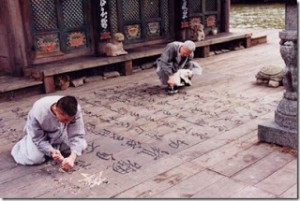After the morning Zazen, we chant the Heart Sutra (Hannya Shingyo) and the Shigu Seigan Mon, accompanied by the bell and the wooden drum, Mokugyo. This is not much for a Morning Ceremony, and yet it is fair to ask, why at all do we chant texts in ancient Japanese (we maybe do not even understand)?
Although in Zen practice I usually suggest to try first, and then ask for the details of how and why, I believe there are some good reasons to stay with these old texts:
- These two texts are kind of basic, all over the world for all Buddhist and Zen schools. In the West, we are about to find our own Way of Zen, but not always we want to break with tradition.
- Our Zen came from Japan, and remembering and keeping alive some of its Japanese roots is o.k.
- It is beautiful, the sound, the unification of mind and body through breath and voice! Also, chanting words which (at least for the beginner) do not make much more sense than blah blah blah does not distract the mind too much, it is a very good exercise!
Of course, the Hannya Shingyo contains some very deep meaning, and part of it is still recited in its original Pali version. But it is o.k. to ignore all this for the time being, and simply enjoy chanting with a loud voice “Maka Hannya Haramita …”

Comments are closed, but trackbacks and pingbacks are open.